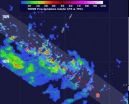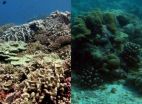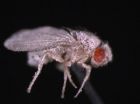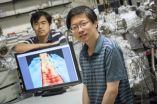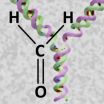(Press-News.org) Edmonton, July 3, 2014 – A research team at the Faculty of Medicine & Dentistry at the University of Alberta have discovered a new way by which metabolism is linked to the regulation of DNA, the basis of our genetic code. The findings may have important implications for the understanding of many common diseases, including cancer.
The DNA wraps around specialized proteins called histones in the cell's nucleus. Normally, histones keep the DNA tightly packaged, preventing the expression of genes and the replication of DNA, which are required for cell growth and division. In order for these critical functions to take place, histones need to be modified with the attachment of an acetyl-group, donated by a critical molecule called acetyl-CoA. This attachment relaxes the DNA, allowing for DNA replication and gene expression. This mechanism is called "epigenetic regulation of DNA" and is important for normal functions (like the growth of an embryo or brain functions) or in common diseases like heart failure or cancer. Until now, how the nucleus generates acetyl-CoA for histone acetylation had remained elusive.
The research team, lead by postdoctoral fellow Gopinath Sutendra and professor Evangelos Michelakis in the Department of Medicine, discovered that an enzyme thought to reside only within mitochondria, called Pyruvate Dehydrogenase Complex (PDC), can actually find its way into the nucleus and do what it is designed to do in the mitochondria: generate acetyl-CoA. When in mitochondria, PDC uses the carbohydrates from our diet to generate acetyl-CoA for energy production. When in the nucleus, PDC can produce acetyl-CoA for histone acetylation.
"Although this jumping of an enzyme from one organelle into another in the cell is not unheard off, our results were quite surprising", Sutendra says. "We wanted to measure acetyl-CoA levels and PDC in the mitochondria because that's where we thought they were. But accidentally we had the nuclei isolated at the same time and we saw PDC in the nucleus. So we asked, 'what is PDC doing there?' And that started it all."
"We were surprised that, despite the recognized importance of histone acetylation in cell biology and medicine, and despite the efforts by many to develop drugs that regulate histone acetylation, the source of acetyl-CoA in the nucleus had remained unknown," Michelakis says. "Sometimes the answers to important biological questions are just next to you, waiting to be discovered," he adds.
The team found that the translocation of PDC into the nucleus made cancer cells grow faster, an observation that may lead to additional strategies in the war against cancer. Yet, because the findings relate to how our DNA is regulated in general, this work may have far broader implications for many physiologic or pathologic conditions where epigenetic regulation is critical. "We are very excited about this new pathway linking energy production (the process known as metabolism) with gene regulation," the researchers say.
The work is published in the July 3, 2014, issue of the journal Cell. Michelakis is particularly proud of the fact that this is the product of a team that is entirely based at the University of Alberta. Many young researchers in the Department of Medicine like Adam Kinnaird, Peter Dromparis and Roxane Paulin were critical members of the team that also included technicians (Trevor Stenson, Alois Haromy, Kyoko Hashimoto) and researchers from the NanoFAB facility (Nancy Zhang, Eric Flaim). The work was funded by the Canadian Institutes for Health Research and the Hecht Foundation (Vancouver, Canada).
INFORMATION:
For more information, or to arrange an interview, please contact:
Ross Neitz, Communications Associate
Faculty of Medicine & Dentistry, University of Alberta
Tel: (w) 780-492-5986, (c) 780-297-8354
rneitz@ualberta.ca
Sweet genes
New way found by which metabolism is linked to the regulation of DNA
2014-07-03
ELSE PRESS RELEASES FROM THIS DATE:
NASA sees rainfall in newborn Tropical Depression 8W
2014-07-03
Powerful thunderstorms in some areas of newborn Tropical Depression 08W in the Northwestern Pacific Ocean were dropping heavy rainfall on July 3 as NASA's Tropical Rainfall Measuring Mission (TRMM) satellite passed overhead.
The eighth depression of the Northwestern Pacific Ocean season formed on July 3 at 0900 UTC (5 a.m. EDT). It was located near 10.0 north latitude and 144.3 east longitude about 240 nautical miles south of Andersen Air Force Base, Guam. Tropical Depression 08W or TD08W had maximum sustained winds near 30 knots (34.5 mph/55.5 kph) and it was moving ...
Safer, cheaper building blocks for future anti-HIV and cancer drugs
2014-07-03
A team of researchers from KU Leuven, in Belgium, has developed an economical, reliable and heavy metal-free chemical reaction that yields fully functional 1,2,3-triazoles. Triazoles are chemical compounds that can be used as building blocks for more complex chemical compounds, including pharmaceutical drugs.
Leveraging the compound's surprisingly stable structure, drug developers have successfully used 1,2,3-triazoles as building blocks in various anti-HIV, anti-cancer and anti-bacterial drugs. But efforts to synthesize the compound have been hampered by one serious ...
Tropical Storm Douglas weakening in the eastern Pacific
2014-07-03
Tropical Storm Douglas is on a weakening trend, according to the National Hurricane Center, and satellite imagery showed that the storm appeared more elongated on July 3.
NOAA's Geostationary Operational Environmental Satellite or GOES-West satellite captured visible data on Douglas just after sunrise on July 3 at 13:15 UTC (9:15 a.m. EDT). The data from GOES-West was made into an image at NASA/NOAA's GOES Project at the NASA Goddard Space Flight Center in Greenbelt, Md.
Forecaster Stewart at the National Hurricane Center cited that Douglas' thunderstorm activity had ...
Rethinking the reef
2014-07-03
A new study by biologists at San Diego State University and Scripps Institution of Oceanography shows that inhabited coral islands that engage in commercial fishing dramatically alter their nearby reef ecosystems, disturbing the microbes, corals, algae and fish that call the reef home.
The study's lead author, Linda Wegley Kelly, is a postdoctoral scholar in the lab of SDSU virologist Forest Rohwer.
For the study, she looked at seawater samples collected from the surfaces of reefs surrounding all 11 of the Line Islands, a chain of atolls in the central Pacific Ocean. ...
Fruit fly immunity fails with fungus after (space)flight
2014-07-03
Before you swat away the next fruit fly, consider instead just how similar its biological complexities are to our own. In a study published in PLOS ONE, researchers led by Deborah Kimbrell, Ph.D., at the University of California, Davis (UC Davis) and their collaborators, studied how microorganisms may alter fruit flies' immunity in space and in hypergravity, or increased gravity. The article is titled "Toll Mediated Infection Response Is Altered by Gravity and Spaceflight in Drosophila."
This study suggests that having normal gravity or hypergravity on the space station ...
Drug shows promise for effectively treating metabolic syndrome
2014-07-03
(SALT LAKE CITY)—University of Utah researchers have discovered that an enzyme involved in intracellular signaling plays a crucial role in developing metabolic syndrome, a finding that has a U of U spinoff company developing a drug to potentially treat the condition.
The researchers, led by Jared Rutter, Ph.D., professor of biochemistry, hope to begin human clinical trials of a drug in the next couple of years.
"The approved drug therapies do not treat or prevent this condition in most people," says Rutter, senior author of a study describing the research published ...
With 'ribbons' of graphene, width matters
2014-07-03
MILWAUKEE – Using graphene ribbons of unimaginably small widths – just several atoms across – a group of researchers at the University of Wisconsin-Milwaukee (UWM) has found a novel way to "tune" the wonder material, causing the extremely efficient conductor of electricity to act as a semiconductor.
In principle, their method for producing these narrow ribbons – at a width roughly equal to the diameter of a strand of human DNA – and manipulating the ribbons' electrical conductivity could be used to produce nano-devices.
Graphene, a one-atom-thick sheet of carbon atoms, ...
Bone marrow fat tissue secretes hormone that helps body stay healthy
2014-07-03
ANN ARBOR, Mich. — It has been known for its flavorful addition to soups and as a delicacy for dogs but bone marrow fat may also have untapped health benefits, new research finds.
A University of Michigan-led study shows that the fat tissue in bone marrow is a significant source of the hormone adiponectin, which helps maintain insulin sensitivity, break down fat, and has been linked to decreased risk of cardiovascular disease, diabetes, and obesity-associated cancers. The findings appear in today's online-ahead-of-print issue of Cell Metabolism.
Bone marrow adipose ...
NASA sees Hurricane Arthur's cloud-covered eye
2014-07-03
When NASA's Aqua satellite passed over Tropical Storm Arthur on July 2 at 2:50 p.m. EDT on July 2, it saw a cloud-covered eye as the storm was on the way to becoming a hurricane.
This visible image of Tropical Storm Arthur was captured by the Moderate Resolution Imaging Spectroradiometer or MODIS instrument that flies aboard NASA's Aqua satellite. Arthur's center was over the Atlantic Ocean and east of Florida's northeast coast. By 5 a.m. EDT on July 3, Arthur's eye had formed but remained cloud covered even as the storm hit hurricane-strength with maximum sustained ...
Cellular defence against fatal associations between proteins and DNA
2014-07-03
This news release is available in German.
DNA - the carrier of genetic information - is constantly threatened by damage originating from exogenous and endogenous sources. Very special DNA lesions are DNA-protein crosslinks - proteins covalently linked to DNA. So far hardly anything was known about repair mechanisms specifically targeting DNA-protein crosslinks. Stefan Jentsch's team at the Max Planck Institute of Biochemistry in Martinsried, Germany, now discovered a protease that is able to chop down the protein component of DNA-protein crosslinks, thereby enabling ...
LAST 30 PRESS RELEASES:
Could water, sunlight, and air be all that’s needed to make hydrogen peroxide?
Making quieter dental drills to reduce dental anxiety
Why undisturbed sleep is important to brain injury recovery
Supplement trio shows promise in reversing autism-linked behaviors in mice
People who received emergency or hospital care for hallucinogens six times more likely to be diagnosed with mania
Scientists call for greater focus on conserving whole ecosystems instead of charismatic species
UH engineers making AI faster, reducing power consumption
Crickets munch on microplastics — especially if they have a big mouth
APIC and SHEA announce Joint Healthcare Infection Prevention Advisory Group (HIPAG)
Iron-deficient diet prevents lung cells from fighting the flu
Are primary students prepared to write in a digital world?
In support of the National Institute of Nursing Research
Ants signal deadly infection in altruistic self-sacrifice
Rising complexity in pediatric patients is reshaping hospital care
Continuous glucose monitoring in insulin-treated older adults with diabetes and Alzheimer disease and related dementias
Vitamin D levels during pregnancy and dental caries in offspring
For those living with dementia, new study suggests shingles vaccine could slow the disease
Your pain meds' side effects may be masquerading as heart failure
Carbon monoxide, the ‘silent killer,’ becomes a boon for fuel cell catalysts
Historical geography helps researchers solve 2,700-year old eclipse mystery
SwRI expands High-Viscosity Flow Loop to test equipment moving heavy oils
Insilico Medicine and Atossa Therapeutics publish AI-driven study in Nature's Scientific Reports identifying (Z)-endoxifen as a potential therapeutic candidate for glioblastoma
An overlooked hormone eyed as deadly driver of postmenopausal breast cancer in women with obesity
Study links childhood vaccination to lower risk of drug-resistant bacteria
LLMs choose friends and colleagues like people
Gas stoves and nitrogen dioxide exposure
Beauty linked with metabolic costs of perceiving images
First Nations Australians twice as likely to be digitally excluded: report
Korea University study finds restless legs syndrome linked to Parkinson’s risk—dopamine treatment may be protective
Pusan National University researchers use AI to create optimized engine components that outperform human designs
[Press-News.org] Sweet genesNew way found by which metabolism is linked to the regulation of DNA
